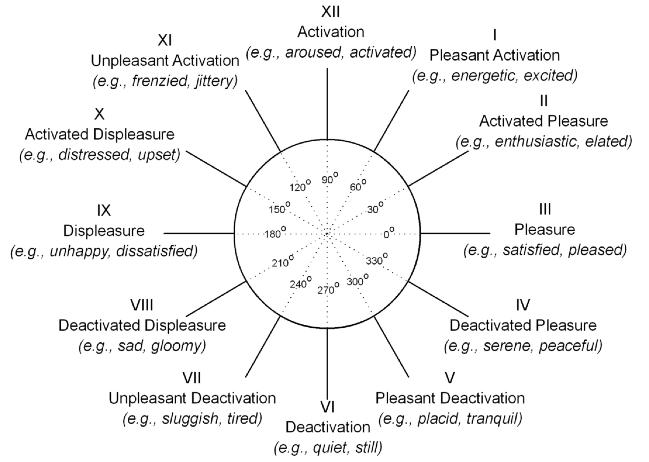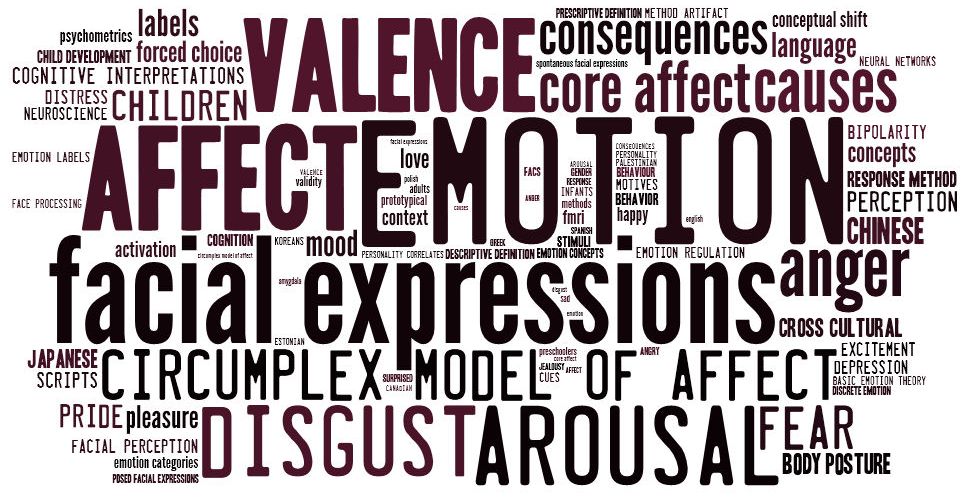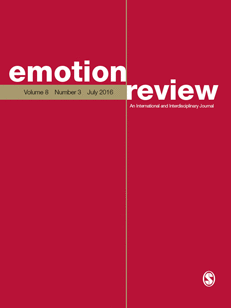An Interview With Andrea Scarantino (October 2016)

James A. Russell is professor of psychology at Boston College. He has published over one hundred scientific papers, all on some aspect of emotion. His current work focuses on an approach to emotion called psychological construction, especially on ways to integrate this approach with other research programs such as appraisal theory and social construction. James was Editor-in-chief of Emotion Review from 2007 – 2014. He has co-edited The Psychological Construction of Emotion (2014) with Lisa Feldman Barrett, and The Psychology of Facial Expression (1997) with Jose Fernandez-Dols.
Where did you grow up? What did your parents do? Can you tell me something about your family?
I grew up in a working-class family in Los Angeles, California. My father worked in a gasoline station, and my mother stayed at home. They divorced when I was 14. My mother went to work in real estate sales, and she continued to work until the day she died. Los Angeles is best known for Hollywood. My paternal grandmother moved to Hollywood when it was movie studios among the orange groves. She appeared in silent films under the stage name Vola Vale. (Here’s a still photo from one of her films: http://fanpix.famousfix.com/gallery/vola-vale). One of my aunts, Virginia Bruce, was also in films, in the 1930s and ‘40s. (She was pretty good; take a look below):
Another aunt, Nancy, was secretary to Bing Crosby’s wife. As a high school student, I worked at Desilu Studios in Hollywood, delivering the mail.
Tell me about your education. Did you develop an early vocation for academic work? What led you to study psychology?

I was educated in a Catholic grammar school and high school. I had no academic ambitions. If fact, I had no particular ambition at all and did not apply to college. But, as an advance-placement high-school student, I took some of my courses at UCLA. I enjoyed those courses, and so I simply stayed on for my college degree. Doing so was possible because I had a scholarship that paid tuition, and I worked in a physics lab for my living expenses. As an undergraduate, I was thinking about religion (I was raised a Catholic, but were the teachings reasonable?) and the big social and political issues of the day (civil rights, Vietnam war). I stayed an undergraduate as long as possible to obtain a deferment from military service in Vietnam, but also because I enjoyed being a student. I would have stayed longer if they had let me. I had a hard time selecting a major because I enjoyed almost all my courses from science and math to history, literature, and philosophy. I began as a physics major, but eventually switched. Psychology was a compromise, in that it combines philosophy with biology, two disciplines I found attractive.
You got your PhD in psychology in 1974 at UCLA. Who were your mentors? Your dissertation focused on how the emotional quality of places affects behavior. Why did you choose this particular topic and what were the main results of your dissertation?

My advisor was Albert Mehrabian, who studied nonverbal communication. I worked in his lab as an undergraduate research assistant. I failed to apply to grad school, but Albert arranged that I could stay on at UCLA as a grad student with a scholarship. I still had no academic ambitions, although I enjoyed research. I benefited from Albert, Bernie Weiner, Hal Kelly, and Peter Bentler – all of whom were personality-social psychologists. In the 1970s, the physical environment was becoming a large social issue (issues such as overpopulation and extinction of species; the first Earth Day occurred). So studying the psychological effects of natural and built physical environments appealed to me. Environmental psychology was emerging as a field, and Albert and I decided to try our hand at it.
Thinking about this topic, it struck me that environments have an uncountable number of effects,  depending on details, but a common factor was that they all tend to have an emotional impact; they create a mood: some are distressing, others relaxing, some exciting, others depressing. I spent my Christmas vacation in 1970 in Mexico taking slides of places that illustrated these emotional qualities and could be used in studies. Research for my dissertation provided the core of the book we wrote (Mehrabian & Russell, 1974). The book offered a simple framework for characterizing the psychological effects of large-scale environments. Environments alter the emotional feelings of people and thereby influence people’s behavior: whether they feel like staying or leaving, affiliating or being alone, working or not, and so on. We drew mainly on prior research to propose a 3-dimensional structure for emotional impact, using the three dimensions of Pleasure, Arousal, and Dominance (PAD). So, my interest in emotion started as an interest in environmental issues.
depending on details, but a common factor was that they all tend to have an emotional impact; they create a mood: some are distressing, others relaxing, some exciting, others depressing. I spent my Christmas vacation in 1970 in Mexico taking slides of places that illustrated these emotional qualities and could be used in studies. Research for my dissertation provided the core of the book we wrote (Mehrabian & Russell, 1974). The book offered a simple framework for characterizing the psychological effects of large-scale environments. Environments alter the emotional feelings of people and thereby influence people’s behavior: whether they feel like staying or leaving, affiliating or being alone, working or not, and so on. We drew mainly on prior research to propose a 3-dimensional structure for emotional impact, using the three dimensions of Pleasure, Arousal, and Dominance (PAD). So, my interest in emotion started as an interest in environmental issues.
What was your first job in academia? Was it hard to find your career path? What do you like most and what do you dislike most about academia?
By 1974, I had finished my PhD and looked for a job. I had no academic ambition, but enjoyed what I had been doing in the Mehrabian lab, and I enjoyed teaching. My first job interview did not go well. No one told me that I would be expected to give a talk, and so had nothing prepared. I did not get that job. The next year, I got several more interviews, for which I did prepare a job talk. I was hired in environmental psychology at the University of British Columbia (UBC), which is in Vancouver, Canada – perhaps the closest place you’ll find to paradise on earth. I tried to do applied work in environmental psychology, but found I had no talent for it. So, I continued with basic research questions, such as the nature of emotion. I wondered, for example, how to reconcile the simple PAD structure (which we used for emotional impact of places) with the appearance of a large (but elusive) number of separate discrete emotions: Could only three dimensions give a good account of people’s avowed discrete emotions, which number in the hundreds, from angst to zeal?
I love academic life. I cannot imagine a better career for me. I get to do what interests me, to work with smart students, and interact with brilliant and caring colleagues. My colleagues are thinking hard about unanswered questions and want their work ultimately to make the world a better place. A university campus (with talks on science and humanities, musical concerts, plays in the drama department, and shows in the art department) is a wonderful place to spend time. At UBC, I did not like mandatory retirement and, because of it, left behind a wonderful department in a wonderful country. I moved to Boston College (which now has a wonderful psychology department as well), where I am now.
The article that really put you on the map as a major figure in affective science is “A circumplex model of affect”, published in 1980 in the Journal of Personality and Social Psychology. Can you briefly explain what inspired the circumplex model, how the model works, and how your understanding of the model has changed since the 1980s?
As an undergraduate research assistant, I had a tiny office with a chalkboard. In trying to make sense of the notion of “emotional impact of places,” I thought about emotions and drew schemas on my chalkboard. The problem was that a list of the hundreds of different emotions was unwieldy, and so I needed a simple way to represent emotion. Based only on my own intuitions, I ended up with a circle with similar emotions near each other and opposite emotions far apart. (So, happy and sad were 180 degrees apart, but happy and thrilled were close to each other.) At UBC, Jerry Wiggins was interested in the circumplex as a mathematical model of the structure of personality traits and interpersonal behavior. I resurrected my emotion circle to apply his idea to emotions.
A circumplex is a mathematical representation of how variables within a domain are related to one another. The variables are arrayed on a circle, and there are ways to assess how well that arrangement fits the data. You begin with a measure of relatedness, usually the correlation coefficient. Variables that are more highly and positively correlated fall closer together on the circle, less correlated farther apart, and negatively correlated farther still. In the affect circumplex, variables on opposite sides of the circle are highly negatively correlated, and variables at right angles to one another are uncorrelated.
The affect circumplex begins by asking people to report their current state by rating the extent to which they feel each item on a list (happy, sad, etc.). The general finding is that different feelings are highly (positively or negatively) correlated: Allegedly discrete emotions are not independent of one another. People who report one negative emotion tend to report many others, for example. Ditto for positive ones. The circumplex model fit our data on self-reported feelings surprisingly well. An updated version of the affect circumplex is shown in Figure 1 below.

Interpretation of this result is another matter and more difficult. One question is whether the feelings assessed are all emotions. Some certainly seemed to be (such as happiness and sadness), but other less so. Still, empirically, all the items were systematically related to one another. Two orthogonal axes of the circle were readily interpretable. The placement of specific feelings around the affect circle suggested underlying dimensions of pleasure and arousal: that is, what the feelings that fall close to one another appeared to have in common was similar pleasure and arousal. Thrilled and excited are close because both are pleasant and aroused. Serene and contented are both pleasant and low in arousal. Feelings that fell on opposite sides of the circle appeared to be opposite in pleasure and arousal. Excited is pleasant and aroused, whereas bored is unpleasant and low in arousal. Pleasure is the continuum from misery to ecstasy. Arousal the continuum from sleep to high energy (what might be called an adrenalin rush.) Complementary evidence on this interpretation of the circumplex was that when pleasure and arousal are assessed directly, they predict self-reported discrete emotions surprisingly well.
The circumplex thus resonated with my earlier work on Pleasure, Arousal, and Dominance (PAD) as representing the emotional impact of places, but left out the D. So, the circumplex didn’t capture everything about emotion (it leaves out not only D but other dimensions as well). An obvious example of differences being left out is that fear and anger are close on the circumplex, because both are unpleasant and high in arousal; so the circumplex does not capture the difference between fear and anger. It captures what various emotions and emotion-related feelings have in common, but not what is unique to a specific emotion. To make sense of what is and what is not captured by the circumplex, I suggested that the circumplex is interpretable as all possible combinations of the P and A dimensions. These two dimensions, in turn, capture a certain aspect of one’s internal state, which, although influenced by the external environment, can vary independently of it (we can simply feel good or bad, energized or enervated, due to no known external circumstance and even despite external circumstances). In contrast, D can be thought of as one’s appraised power relative to external circumstances. D seems to make sense only relative to the outside world. Fear and anger share unpleasant and aroused feelings but differ in the external precipitating cause and in the typical overt behavioral reaction. In short, the circumplex captured an important part of but not the whole of an emotion.
I continue to examine the circumplex, including its underlying neuroscience (Posner, Russell, & Peterson, 2005), the assumption that opposite emotions are mutually exclusive (Russell, in press), the relation of the pleasure axis to the arousal axis (Kuppens et al. in press), and the presence of pleasure and arousal combinations in different cultures (Russell, Lewicka, & Niit, 1989).
Another important strand of your research emerged in the 1980s, and it concerns the structure of emotion concepts. In your work with Beverly Fehr, you argued that the concept of emotion, and the concepts subordinate to it like anger or love, have a prototypical structure. Can you explain what that means, and what evidence you relied on to establish such results? Secondly, are you still committed to a prototype structure for emotion concepts, or are you open to other possible models for emotion concepts (e.g. exemplar models, theory-based models, situated conceptualization models à la Barsalou, etc.), as long as they deny that there are individually necessary and jointly sufficient conditions for something to be an emotion/anger/love and so on?

From my undergraduate days, I was intrigued with Wittgenstein’s philosophical analysis of concepts, according to which, counterintuitively, instances of a given concept do not all share common features but bear only a family resemblance to one another. It seems that the objects or events grouped together under a common name (such as all activities called games) need not have an essential set of features. Concepts defined by individually necessary and jointly sufficient features – often called classical concepts – are achieved by hard work (in math or logic or science), rather than inherited from the language of everyday thinking. In the 1970s, I discovered Eleanor Rosch’s work on everyday semantic categories (e.g., Rosch, 1973). Eleanor pioneered empirical methods to examine everyday semantic categories and found that they possess an internal structure (some dogs are doggier than others; think German shepherds vs chihuahuas) and borderline cases (elevators are not only poor examples of a vehicle, but might not be vehicles at all, in the sense that ordinary language users are evenly split on their status as vehicles and the same person sometimes changes his or her mind when asked a second time). Many everyday terms label family resemblance concepts rather than classical concepts.

Bev Fehr and I used Rosch’s methods to look at the everyday concepts of emotion, love, anger, and so on. We reported reaction time studies and task performance studies to make the case that emotion concepts fit Rosch’s account (Fehr & Russell, 1984, 1991; Fehr, Russell & Ward, 1982; Russell & Fehr, 1994). Native speakers of English do not have classical definitions for these everyday concepts in terms of individually necessary and jointly sufficient features, even implicitly (they are unsure how to answer certain questions and disagree with each other and even with themselves over time). Instead, emotion concepts have a graded internal structure: some instances of emotion/love/anger are clear and prototypical cases, some are clear but non-prototypical cases, some are at the borderline for membership (borderline cases), and some are clear non-cases. For example, fear is a clear and prototypical type of emotion, regret is a clear but non-prototypical type of emotion, and serenity and boredom are borderline types of emotion. Indigestion is not an emotion. In addition, sentences that seem obviously true about emotion (including sentences about emotion taken from textbooks) – e.g., emotions are a stirred up state of mind – are judged by subjects to hold true about the prototypical cases but not true about the non-prototypical and borderline cases (e.g. anger involves feeling stirred up, but neither regret nor boredom do).
To capture this structure, Bev and I suggested that the prototype of, for example, fear can be thought of as a script with prototypical subevents arranged in a causal and temporal order. These subevents (appraisal of the antecedent precipitating event, changes in peripheral physiology, expressive signs, conscious feelings, and overt expressive and instrumental behavior) are now commonly called components. Actual events are members of the category ‘fear’ to the extent they resemble the script, but resemblance is a matter of degree. Put differently, a script is a kind of schema or template. People rely on schemas to process the events they experience or witness by assimilating information to a familiar structure.
On your second question, I have no strong preference for prototype structure over exemplar models, theory-based models, etc. for everyday concepts. I was satisfied to argue against the classical view. I’ll leave it to cognitive psychologists to determine the best alternative.
Is there a difference between the concepts of emotions held by adults and by children?
 Sherri Widen and I have studied the development of emotion concepts, which, indeed, change considerably with experience (Widen & Russell, 2002, 2004, 2008, 2010). Children’s earliest emotion concepts are simple, perhaps merely distinguishing positive from negative emotions, but they then gradually differentiate until the adult structure is reached. I believe that the positive – negative distinction is pancultural, but that further differentiation stems from some combination of preparedness and learning rather than simple maturation. Evidence for this suggestion is that the adult structure varies from one individual to the next, from one society to the next, and from one historical period to the next, although the structures show similarity as well. If so, then we should not assume that the semantic structure for emotion concepts that English-speaking children eventually reach is somehow privileged or inevitable or necessary. Those children would develop somewhat different concepts if they grew up in a different culture and spoke a different language.
Sherri Widen and I have studied the development of emotion concepts, which, indeed, change considerably with experience (Widen & Russell, 2002, 2004, 2008, 2010). Children’s earliest emotion concepts are simple, perhaps merely distinguishing positive from negative emotions, but they then gradually differentiate until the adult structure is reached. I believe that the positive – negative distinction is pancultural, but that further differentiation stems from some combination of preparedness and learning rather than simple maturation. Evidence for this suggestion is that the adult structure varies from one individual to the next, from one society to the next, and from one historical period to the next, although the structures show similarity as well. If so, then we should not assume that the semantic structure for emotion concepts that English-speaking children eventually reach is somehow privileged or inevitable or necessary. Those children would develop somewhat different concepts if they grew up in a different culture and spoke a different language.
Your last remark leads me to ask about cross-cultural differences in emotion concepts. In your “Culture and the Categorization of Emotion” (1991a, Psychological Bulletin), you reviewed the literature then available on how emotions are conceptualized in different cultures. Can you summarize some highlights from your review?
 Much academic work on emotion takes the English word emotion to define the domain of study, and thus to specify the set of events that any theory of emotion must explain. Similarly, words for specific emotions (anger, sadness, fear, happiness) are treated as fundamental concepts in scientific theories of that domain. The question whether these English terms are good scientific tools prompted me to ask whether they are specific to Western culture or even English-speaking cultures. So, I searched for ethnographic accounts of emotion lexicons. Not all languages have a term translatable as emotion. Some English words for specific emotions have no translation equivalent in some other languages, and vice versa.
Much academic work on emotion takes the English word emotion to define the domain of study, and thus to specify the set of events that any theory of emotion must explain. Similarly, words for specific emotions (anger, sadness, fear, happiness) are treated as fundamental concepts in scientific theories of that domain. The question whether these English terms are good scientific tools prompted me to ask whether they are specific to Western culture or even English-speaking cultures. So, I searched for ethnographic accounts of emotion lexicons. Not all languages have a term translatable as emotion. Some English words for specific emotions have no translation equivalent in some other languages, and vice versa.
Perhaps the best known example is the Japanese word amae, which has no equivalent in English, and which designates a pleasant state of childlike dependence on an authority figure. Tahitians lack a word that translates as sad. The Baining people of Papua New Guinea have the category of awumbuk, which combines sadness, lassitude, tiredness, and boredom caused by the departure of visitors, friends, or relatives. Indeed, closer examination of what had been taken to be translation equivalents indicates that some are not equivalent. This review reinforced my growing conviction that English emotion terms are not inevitable as fundamental concepts in scientific theories in our domain of inquiry. If everyday terms are asked to work as scientific terms, I could see no reason why English should be privileged in science over other languages.
Can you say more about how your work on the prototype structure and cross-cultural variability of emotion concepts has affected your understanding of how emotions themselves should be scientifically studied? How does the structure of emotion concepts relate to your distinction between descriptive and prescriptive definitions of emotions (Russell, 1991; Widen & Russell, 2010b)?
It is essential that we distinguish (as you just did) concepts from the events they are concepts of. The prototype structure (actually evidence against a classical definition), the developmental changes, the individual differences in adult concepts, and the cultural and historical variability of emotion terms all contributed to my concern that ordinary everyday emotion concepts labeled in English might not deserve the status commonly given them by psychologists in their theories of the events they are concepts of. Folk emotion terms in English, and for that matter in any natural language, are likely unsuitable to serve as technical terms in scientific theories. This problem is not the exception but the norm in science, as the history of science shows us that folk concepts rarely survive as scientific concepts. If they did, folk physics would resemble scientific physics, folk biology would resemble scientific biology, and they clearly do not. The lesson here is that mining everyday language for deep truths about emotion might be as problematic as asking people in the street about the structure of the physical or biological world.
Admittedly, everyday terms historically serve as starting places in building a scientific account of some domain; still, they can be but need not be in the final account. (Constellations of stars have no role today in scientific theories in astronomy.) After decades of developing the basic emotion research program, Izard (2010, p. 383), remarked that “I agree that the term emotion may have a fate in psychological science similar to the term constellation in the science of astronomy.” Indeed, perhaps the folk emotion terms have led us astray. If English emotion terms are scripts with culture-specific assumptions, then those terms require rather than provide explanation.
The question of how to “define” emotion, anger, love, and so on is repeatedly raised, with little appearance of progress despite centuries of attempts. I think that lack of progress is due to a muddle between two kinds of definition, based on the distinction between concepts and the events they are concepts of. One type we discover, the other we stipulate. Ordinary English terms label concepts that are used in everyday life in many important ways, and so we must study those terms; we must discover a descriptive definition for them. That is, we must describe the meaning of those words as that meaning exists in everyday folk use of the terms. Similarly, we must describe the folk terms in other languages and study the role of those (more obviously culturally specific) terms. In this case, we do not critique or improve the concepts but describe them as they are, problematic assumptions and all. Everyday terms play a role in psychological processes, and that role must be described – just as a belief in witches played a role in lives and deaths centuries ago and those beliefs must be studied, not taken as true.
On the other hand, we are not obligated to use those ordinary language terms, and the concepts that underlie them, in building scientific accounts of the events the words refer to. Instead, scientists need to stipulate prescriptive definitions for terms (whether labeled with the folk labels or with new ones), which dictate how the terms ought to be used for the purposes of a scientific theory of the events referred to. In this case, we must critique the proposed concepts and work to improve them. Even though folk concepts are not classical, scientists can create classical concepts by stipulating a prescriptive definition. An analogy can be seen in the difference between two scientific tasks. An anthropologist has the task of describing a particular society’s taxonomy of local plants. A botanist has the very different task of developing a scientific taxonomy of those same plants. Botanists have created concepts for this task. The two taxonomies have turned out to be quite different. For emotions, psychologists have both the descriptive and the prescriptive tasks, but it is important to see the difference.
The events that the words emotion, anger, love and so on refer to are real and important. People experience and witness and fall victim to and rejoice in these events. Studying them is essential to human progress. The question I raise is how to study these events.
In 1994, you became public enemy number 1 for the basic emotion research program. In “Is there universal recognition of emotion from facial expression? A review of the cross-cultural studies” (Psychological Bulletin), you argued that the evidence of universality of facial expressions, hailed up to that point as the strongest form of evidence for basic emotion theory, was bogus. Can you summarize what were your main complaints about the sort of facial expression research conducted by basic emotion theorists? Do you regret the tone that your exchanges with Ekman took in the following years?
 When I moved to UBC as an Assistant Professor, I started teaching a course on emotion. Like other emotion researchers at that time, I taught students about facial expressions, highlighting the Ekman-Friesen-Sorenson research in the highlands of Papua New Guinea. This team had trekked there to find a society relatively isolated from Americans and Europeans. Despite their isolation, the Papua New Guineans recognized the same emotions from facial expressions as did Europeans and Americans – or so it seemed. This evidence had quickly made its way into the textbooks as providing strong support for basic emotion theory. To teach this material, I had the students in my class act as participants in classroom demonstrations of the research methods. To my surprise, it quickly became apparent that the results depended on the exact details of the study. I could show a photo of a facial expression and write a list of emotion terms on the chalkboard; students agreed on the emotion the face conveyed. But then, as the students watched, I could erase one term and add another, and the students would agree on a different emotion for the same face. So, I read the literature more carefully, did studies on methodological choices, and wrote the paper you referred to.
When I moved to UBC as an Assistant Professor, I started teaching a course on emotion. Like other emotion researchers at that time, I taught students about facial expressions, highlighting the Ekman-Friesen-Sorenson research in the highlands of Papua New Guinea. This team had trekked there to find a society relatively isolated from Americans and Europeans. Despite their isolation, the Papua New Guineans recognized the same emotions from facial expressions as did Europeans and Americans – or so it seemed. This evidence had quickly made its way into the textbooks as providing strong support for basic emotion theory. To teach this material, I had the students in my class act as participants in classroom demonstrations of the research methods. To my surprise, it quickly became apparent that the results depended on the exact details of the study. I could show a photo of a facial expression and write a list of emotion terms on the chalkboard; students agreed on the emotion the face conveyed. But then, as the students watched, I could erase one term and add another, and the students would agree on a different emotion for the same face. So, I read the literature more carefully, did studies on methodological choices, and wrote the paper you referred to.
Subsequently, issues of method appeared to be even more troublesome than I had originally thought. For example, consider the commonly used multiple-choice response format. With that format, Nicole Nelson in my lab found that native speakers of English agree that a novel facial expression (one that no one has suggested is a signal of any emotion) conveys the emotion of “pax” –- even though “pax” is a made-up word (Nelson & Russell, 2016; in press). So, we have to wonder just what conclusion follows when the same response format is used to show that people agree that, say, a nose scrunch conveys the emotion of disgust. Another aspect of method commonly used is to show observers many different expressions. With one set of prior expressions, the nose scrunch is consensually found to convey disgust, but with a different set of prior expressions, the same nose scrunch is consensually found to convey anger (even when the label disgust is one of the alternatives available on the response format in both cases.) As a result of these methodological obstacles, the substantive issues remained unresolved. A project I’m involved with recently sent a team of a psychologist (Carlos Crivelli) and an anthropologist (Sergio Jarillo) back to Papua New Guinea to carry out studies similar to those of the Ekman-Friesen-Sorenson expedition. Using a range of methods, these researchers found results that, so far, fail to support basic emotion theory. (See, for example, Crivelli et al., 2016)
Regret the tone? Not at all. Everyone concerned did their job of articulating their point of view. We need more such debates.
In your recent debate on facial expression with Keltner, Cordaro and Fridlund published in Emotion Researcher, it became apparent that there is more agreement between opposing research programs on the nature and function of facial expressions now than there was in the early 1990s. What are the outstanding matters of contention concerning the universality of facial expressions? Finally, do you find that these debates lead to genuine progress? If not, what is the main obstacle standing in the way of progress?
That emotions produce (i.e., cause) facial expressions and that humans panculturally interpret facial expressions as conveying specific emotions – the account provided by basic emotion theory — remains contentious. For example, the theory that disgust makes you reflexively scrunch your nose, and that humans (whatever their culture) recognize disgust from the scrunched nose (whatever the context) remains controversial. Thus, the most fundamental issues in this area of research remain unresolved.
The evolutionary theory offered by Alan Fridlund and even the theory offered by Dacher Keltner and Dan Cordaro are noticeably different from the theory of Tomkins, Ekman, and Izard. Still, the Keltner-Cordaro theory falls within the basic emotion research program because it analyzes the human emotional repertoire in terms of a limited number of discrete pre-packaged emotional responses, some of which include a universal signaling system. The issue we discussed here earlier concerned the interpretation of facial expressions (commonly called recognition or decoding), and there is complementary evidence (gathered for example by Jose Miguel Fernandez Dols) on the production of facial expressions during emotional states (also called encoding). Enough evidence on both interpretation and production speaks against the basic emotion program that it is time to pursue alternatives. My alternative view is that there are an uncountable number of different emotional episodes, most of which are assembled on the fly in a way highly sensitive to context, and that there is no universal emotion signaling system (Russell, 2003).
Genuine progress? I don’t see great progress, but then science can be frustratingly slow. Old flawed methods continue to be used. If the basic- emotion approach to facial expressions fails, we are still left with the questions of why people move their faces as they do and how observers interpret facial movements. So, we’re back to square one, albeit now with a good number of alternative proposals to consider.
I believe that progress in the study of emotion is slowed by conceptual vagueness. Vague non-quantitative statements based on fuzzy concepts and incomplete theories do not lend themselves to rigorous testing with definitive conclusions. As a result, our accounts are less data driven than they should be. Theories linger. For example, consider the hypothesis that “disgust makes you scrunch your nose.” Imagine a study that finds only a minority of disgusted people scrunching their noses. This evidence might be dismissed by an advocate for basic emotion theory on the grounds that some people did scrunch their nose, that those who did not were not intensely disgusted, or that their nose scrunch was inhibited. The problem is that the original hypothesis did not specify how many disgusted people are predicted to scrunch their noses. Nor did it specify in testable terms just what disgust is (subjective conscious experience? the cause of the subjective experience? a neural event?). No clear assessment of “intensity” has been developed (although self-report scales exist, they are sometimes dismissed as unreliable and seem to presuppose that disgust is something reportable). No complementary theory of the circumstances in which the nose scrunch is or is not inhibited has been developed. As a result, one can continue to believe the hypothesis whatever the evidence.
I used basic emotion theory as an illustration here because it is the dominant theory in affective science, but conceptual vagueness and incomplete theories are widespread. Earlier, I suggested that the adult emotion taxonomy results from both preparedness and learning. That claim provides no clear predictions and is consistent with any set of empirical findings. I tried to move toward greater precision by stipulating a definition for “core affect,” but much remains unspecified and incomplete about that concept too.
In 1999, you and Lisa Barrett published “Core affect, prototypical emotional episodes, and other things called emotion: Dissecting the elephant” (Journal of Personality and Social Psychology), a first step towards the development of psychological constructionism. In the article, you explored the relation between what you called ‘core affect’ and what you called ‘prototypical emotion episodes’. What is your current understanding of such relation? How does the 1999 model differ from the circumplex model you presented in 1980?
This article was invited by the journal’s editor, Ed Diener, and gave us an opportunity to connect the affect circumplex with the script account of emotion concepts. Lisa and I had concluded that mounting evidence challenged basic emotion theory. We could begin to develop an alternative.
 Our alternative began by interpreting what the affect circumplex represented as core affect. We used the term core affect because we could then stipulate its meaning: the neurophysiological state that is typically available to consciousness as felt variations in hedonic valence (pleasure-displeasure) and degree of arousal: feeling good or bad, energized or enervated. The circumplex dimensions of pleasure and arousal are dimensions of subjective experience of one’s internal state, often felt in an integrated fashion, seen especially clearly in moods and emotions, but, importantly, available (although not always attended to) at all times. Thus, core affect is important in contexts we might not call emotional, as in vague moods or when feeling ill or when we seek to regulate core affect: look for some fun, seek a place to relax, avoid an acquaintance who is boring, or have a coffee to perk up. (Many psychologists are reluctant to talk about subjective experience, perhaps a leftover from Behaviorism. But I think consciousness is a natural process as much subject to scientific scrutiny as any other.) Core affect is what was captured by the 1980 circumplex model.
Our alternative began by interpreting what the affect circumplex represented as core affect. We used the term core affect because we could then stipulate its meaning: the neurophysiological state that is typically available to consciousness as felt variations in hedonic valence (pleasure-displeasure) and degree of arousal: feeling good or bad, energized or enervated. The circumplex dimensions of pleasure and arousal are dimensions of subjective experience of one’s internal state, often felt in an integrated fashion, seen especially clearly in moods and emotions, but, importantly, available (although not always attended to) at all times. Thus, core affect is important in contexts we might not call emotional, as in vague moods or when feeling ill or when we seek to regulate core affect: look for some fun, seek a place to relax, avoid an acquaintance who is boring, or have a coffee to perk up. (Many psychologists are reluctant to talk about subjective experience, perhaps a leftover from Behaviorism. But I think consciousness is a natural process as much subject to scientific scrutiny as any other.) Core affect is what was captured by the 1980 circumplex model.
Core affect is an aspect of core self. We distinguished core affect from affective judgments about the external world. Although core affect and such judgments often go hand in hand, they are separable, as when we feel core affect for no known reason (I can wake up simply feeling bad without knowing why and without judging anything). Conversely, we sometimes make affective judgments without much feeling (I can judge an ancient battle as sad without actually feeling sad).
The concept of core affect puts that subjective feeling at the heart of mood, emotion, and other processes. Core affect is one of the component parts of emotion episodes, which also include appraisals, behavioral and peripheral physiological changes, expressive changes, neural changes and so on. A caveat here is that evidence that emotion concepts are scripts lacking necessary or sufficient features suggested that not even core affect is defining of everyday concepts. In fear, for example, we prototypically feel bad and highly aroused. On the other hand, we can enjoy a horror movie or a dangerous sport and still call the experience fear. Such episodes suggest the existence of fear episodes without the typical core affect. (Presumably, enough other components resemble the fear script for such episodes to count as fear.) Cases of fear that include feeling bad and aroused resemble the script more closely than do cases lacking this core affect, all else equal, and are thus more prototypical. (The same variability exists for other components of the fear script: episodes lacking flight, for example, can still count as fear if enough other components resemble the script.)
This caveat has to do with what counts as a member of an everyday category. These matters of definition aside, core affect is a pervasive process. Core affect gives emotional episodes their heat, their raw feeling. Events, either directly or as interpreted, change core affect. Core affect, in turn, can guide information processing (as in mood-congruent judgments and memory) and behavior (we are motivated to act to feel good or avoid feeling bad; our plans for action take into account how much energy we feel we have).
In 2003, you published your influential “Core affect and the psychological construction of emotion” (Psychological Review), which officially launched psychological constructionism as a scientific research program. What are the main tenets of psychological constructionism? Can psychological constructionism be integrated with other research programs, and if so how?
The notion of psychological construction begins in the skepticism about the main way in which emotions have been conceptualized over the centuries, borrowing its key terms from fuzzy everyday talk, not always distinguishing concepts from the events they are concepts of, and neglecting developmental, individual, and cultural differences in those concepts. I had specific concerns about the dominant theory of emotions – basic emotion theory – which is a modern articulation of the centuries-old folk view of emotion. I criticized basic emotion theory for its reliance on flawed evidence of universality for facial expressions. I was also aware of controversy surrounding the claim of patterns of activation in the peripheral nervous system that corresponded to the theorized basic emotions. There was mounting evidence that it is rare that a stimulus simply and automatically triggers an emotion, but that a considerable amount of appraisal and attribution is typically required. And, finally, simple observations indicated a weak relation between emotion and overt instrumental behavior.
 Psychological construction starts with different assumptions. The set of events categorized in everyday language as emotion or fear or anger and so on have no constituent operations that are necessary and sufficient. Of course, the brain is doing the work, but most emotional episodes are not products of neural modules; they are not hardwired response packages. The set of episodes labeled, in English, as “fear” is a heterogeneous set of events that bear only a family resemblance to one another. By “heterogeneous,” I mean that the set includes reflexes but also episodes that are highly sensitive to the immediate circumstances, as interpreted, and what the person brings to the situation. As a result, the set includes an uncountable variety of specific responses to those circumstances. The set called “emotion” includes all the variability of its subordinate categories (fear, anger and so on). Emotion includes such a great variety of responses that no one theory will capture them all, short of all of psychology. Thus, the lay word emotion does not capture a qualitatively different domain for study.
Psychological construction starts with different assumptions. The set of events categorized in everyday language as emotion or fear or anger and so on have no constituent operations that are necessary and sufficient. Of course, the brain is doing the work, but most emotional episodes are not products of neural modules; they are not hardwired response packages. The set of episodes labeled, in English, as “fear” is a heterogeneous set of events that bear only a family resemblance to one another. By “heterogeneous,” I mean that the set includes reflexes but also episodes that are highly sensitive to the immediate circumstances, as interpreted, and what the person brings to the situation. As a result, the set includes an uncountable variety of specific responses to those circumstances. The set called “emotion” includes all the variability of its subordinate categories (fear, anger and so on). Emotion includes such a great variety of responses that no one theory will capture them all, short of all of psychology. Thus, the lay word emotion does not capture a qualitatively different domain for study.
My alternative assumption is that the events characterized in folk terms are not themselves basic features of the mind but are constructed from more basic psychological operations: fear is not a basic operation but is constructed from more basic operations that are not unique to emotion.
A science of emotional episodes needs more sharply defined technical concepts that lend themselves to rigorous testing. We need to identify the basic operations that constitute emotional episodes, and progress has been made in doing so. Most affective scientists now agree on the “multi-componential nature” of emotional episodes: An emotional episode typically consists of coordinated components, such as appraisals, attributions, changes in peripheral physiology, changes in face and voice, subjective experiences, overt behavior. The question is how these components are related to each other.
One of the most surprising findings of research on emotion is the weakness of the correlations among these components. So, psychological construction also starts with the assumption that components are not pre-packaged. Instead, the weakness of the correlations among components suggest that each component is best treated as its own process, its own causal chain of events. (The illusion that the components are strongly linked may stem from a comparison of the extremely prototypical case with its opposite: extreme fear of the bear in the woods might have all the prototypical components co-occurring when compared to a state of serenity. The weakness of the correlations shows up when a broader sample of cases is studied.)
The links are weak because they are not pre-determined. Instead, each component depends on circumstances. So, on a psychological construction account, when some danger occurs and a fear episode is constructed, each component process proceeds somewhat on its own. Perceptual-cognitive processes monitor the situation. Part of perception is moving the head and face to see better; hence the widening eyes part of the “fear expression” might occur if the danger is something to be seen but not otherwise. Behavioral processes typically include goal setting, making plans to achieve the goal, and executing the plan while monitoring progress. Peripheral physiology is adjusted as behavior is prepared and executed. If the danger is a bear, you might prepare to flee, but if the danger is failing an exam, you might sit down to study, maybe. If the danger is in the distant future, you might do nothing immediately. Peripheral physiological changes differ in these different cases. We sometimes monitor these processes and interpret our own state, as in “I’m scared,” but sometimes we don’t or not until much later, and sometimes we get it wrong.
Since the 2003 article, various researchers can be associated with psychological construction besides Lisa Barrett and myself: Jose Miguel Fernandez Dols, Jerry Clore, Andrew Ortony, Wil Cunningham, Kristen Lindquist, Sherri Widen, and Joe LeDoux, for example. These researchers are of course developing their own ideas, but their accounts bear a family resemblance.
On integration, the science of emotion suffers from being divided into camps and disciplines. I think that integration is the next big item on our agenda. Colleagues within the basic emotion program are thinking of how to integrate evolutionary ideas with cultural differences. The goal of integrating psychological construction with other research programs is the important next step on my agenda. How? That remains to be seen, but Lisa and I are thinking about it, and we edited a book (The Psychological Construction of Emotion) with that as one of its themes. I know that others are thinking about it as well: Jim Averill working from a social constructionist perspective, Agnes Moors from an appraisal theory and dual-process action theory perspective.
You have been, jointly with Lisa Barrett, the first editor of Emotion Review (2009-2011), which you edited on your own for 1 year (2012) after Lisa left the editorship, and was taken over by Christine Harris in 2015 (Christine had been a co-editor since 2013). The Emotion Review has been very successful, as testified by its most recent IF factor of 4.730, which gives it a 12/129 ranking in Psychology, Multidisciplinary. How was the experience of being an editor for you? What are you most proud of with respect to the journal?
 Lisa and I had the idea of an emotion journal that would focus on conceptual issues, be open to all viewpoints, and be a venue for confrontation of disparate theories. We hoped for genuine dialogue across disciplines. I am proud that we got just such a journal started. I greatly enjoyed the experience, interacting with people from different disciplines and countries, and with different concerns and viewpoints. My hope is that, for new ideas and analyses on emotion, Emotion Review comes to be preferred as the outlet over even a top journal in the author’s home discipline.
Lisa and I had the idea of an emotion journal that would focus on conceptual issues, be open to all viewpoints, and be a venue for confrontation of disparate theories. We hoped for genuine dialogue across disciplines. I am proud that we got just such a journal started. I greatly enjoyed the experience, interacting with people from different disciplines and countries, and with different concerns and viewpoints. My hope is that, for new ideas and analyses on emotion, Emotion Review comes to be preferred as the outlet over even a top journal in the author’s home discipline.
You are one of the most cited affective scientists in the world, with 43,462 total citations, and an h-index of 72 and an i10-index of 139. Congratulations about that! Do you always have a sense that one of your papers will be a hit once you complete it? Do you think you best work is your most cited work, or is there a less known side of your research that you would like to be better known?
Thank you, Andrea. (But remember that you have to divide those numbers by 43, which is the number of years I’ve been publishing.) When I submit a paper, I am not thinking about a “hit,” but about how to deal with the inevitable negative reviews and rejections. I have a few pieces that I thought presented interesting ideas but that didn’t catch much attention, but then maybe they weren’t so interesting.
Can you describe your typical workday?
Long ago, to find some quiet time away from my children, I developed the habit of getting up early. When I was chair of the psychology department at Boston College, I found that an email at 4 am got the attention of my colleagues. I no longer work after late afternoon, but get some fresh air, exercise, read (fiction), listen to music, or watch old movies. These days, I waste a lot of time scanning the internet for news about our troubled world. Humans cause so much trouble; someone should study them.
Are there any aspects of academic psychology that you think would benefit from major changes, from the way we teach, to the way we recruit students and colleagues, to the way we tenure, to the way we allocate grants?
The way that the academy is divided into disciplines is an historical accident, and we would benefit from fewer barriers and more interdisciplinary collaboration. Even within a discipline, we need to reconcile our differences more effectively. We need to state our disagreements clearly, listen to the other side, and address their points directly.
My experience suggests that universities are lucky to have us as teachers and department citizens. My colleagues genuinely care about teaching, about their students, and about their colleagues. I wish that the tenure process, as it is in the USA, were different, with multiple paths rather than publish-or-perish. I wish that reviewers and editors in the peer review process did not see their reviews as an opportunity to increase the number of citations to their own articles.
But my biggest complaint is with the funding situation. Along with Sherri Widen, I spent at least two full years applying to various agencies for grant funds, to no avail. Colleagues have told me similar stories. My experience on various funding agency panels is that many proposals are good, and so funding only a small percentage of good proposals is a shame. Much grant proposal writing is wasted effort. That effort might be better spent actually doing research. For example, psychology is supposedly undergoing a “replication crisis.” Perhaps more research should be replicated in other labs before it is published.
What are you working on these days?
I have been lucky to work with some very talented students. Recent students (Sherri Widen, Mary Kayyal, Nicole Nelson) are developmental psychologists, and I continue to follow their lead in research on children’s understanding of emotion. A current student (Dolichan Kollareth) is interested in moral emotions and in cultural differences. With Carlos Crivelli and Jose Miguel Fernandez Dols, I’m looking at cultural differences in interpretation of facial expressions. My bigger project, though, is the “greater constructionist project,” which has the goal of integrating psychological construction with other research programs on emotion. I’m optimistic that integration is possible with appraisal theories. I’m working with Agnes Moors on some of that. I’m working with Disa Sauter to find areas of agreement with the basic emotion approach.
What are the most pressing questions we should try to answer in contemporary affective science?
We need to move away from the folk preconceptions about emotion and toward more clearly defined and testable propositions. Emotion has a bad reputation (as responsible for bad decisions and actions) that might not be deserved. As a next step, we need to find ways to integrate the different conceptual frameworks that now guide research and application. History suggests that no one of the current frameworks (including mine) will be the final word, but each is based on a valuable insight. Once we have more clearly defined concepts and testable propositions, evidence will more forcefully compel progress.
References
Some of the following references are available for download at http://emotiondevelopmentlab.weebly.com/lectures–publications.html
Barrett, L. F., & Russell, J. A., Eds. (2015). The psychological construction of emotion. New York: Guilford Press
Crivelli, C., Jarillo, S., Russell, J. A., & Fernandez-Dols, J. M. (in press). Reading emotions from faces in two indigenous societies. Journal of Experimental Psychology: General.
Fehr, B., & Russell, J. A. (1984). Concept of emotion viewed from a prototype perspective. Journal of Experimental Psychology: General, 113, 464-486.
Fehr, B., & Russell, J. A. (1991). The concept of love viewed from a prototype perspective. Journal of Personality and Social Psychology, 60, 425-438.
Fehr, B., Russell, J. A., & Ward, L. M. (1982). Prototypicality of emotions: A reaction time study. Bulletin of the Psychonomic Society, 20, 253-254.
Kuppens, P., Tuerlinckx, F., Yik, M., Koval, P., Coosemans, J., Zeng, K. J., & Russell, J. A. (in press). The relation between valence and arousal in subjective experience varies with personality and culture. Journal of Personality.
Mehrabian, A., & Russell, J.A. (1974). An approach to environmental psychology. Cambridge, Mass.: MIT Press.
Nelson, N. L., & Russell, J. A. (2016). A facial expression of pax: Assessing children’s “recognition” of emotion from faces. Journal of Experimental Child Psychology, 141, 49-64.
Nelson, N. L., & Russell, J. A. (in press). Building emotion categories: Children use a process of elimination when they encounter novel expressions. Journal of Experimental Child Psychology.
Posner, J., Russell, J. A., & Peterson, B.S. (2005). A circumplex model of affect: An integrative approach to affective neuroscience, cognitive development, and psychopathology. Development and Psychopathology, 17, 715-734.
Rosch, E. H. (1973). Natural categories. Cognitive psychology, 4, 328-350.
Russell, J. A. (in press). Mixed emotions viewed from the psychological constructionist perspective. Emotion Review.
Russell, J. A. (1991a). Culture and the categorization of emotion. Psychological Bulletin, 110, 426-450.
Russell, J. A. (1991b). Natural language concepts of emotion. In D. J. Ozer, J. M. Healy, Jr., & A. J. Stewart (Eds.), Perspectives in personality: Self and emotion (pp. 119-137) London: Jessica Kingsley.
Russell, J. A. (1994). Is there universal recognition of emotion from facial expression? A review of the cross-cultural studies. Psychological Bulletin, 115, 102-141.
Russell, J. A. (2003). Core affect and the psychological construction of emotion. Psychological Review, 110, 145-172.
Russell, J.A., & Barrett, L. F. (1999). Core affect, prototypical emotional episodes, and other things called emotion: Dissecting the elephant. Journal of Personality and Social Psychology, 76, 805-819.
Russell, J. A., & Fehr, B. (1994). Fuzzy concepts in a fuzzy hierarchy: varieties of anger. Journal of Personality and Social Psychology, 67, 186-205.
Russell, J.A., Lewicka, M., & Niit, T. (1989). A cross-cultural study of a circumplex model of affect. Journal of Personality and Social Psychology, 57, 848-856.
Widen, S. C., & Russell, J. A. (2002). Gender and the perception of emotion. Merrill-Palmer Quarterly, 48, 248-262.
Widen, S. C., & Russell, J. A. (2004). The relative power of an emotion’s facial expression, label, and behavioral consequence to evoke preschoolers’ knowledge of its cause. Cognitive Development, 19, 111-125.
Widen, S. C., & Russell, J. A. (2008). Young children’s understanding of other’s emotions. Handbook of emotions, 3, 348-363.
Widen, S. C. & Russell, J. A. (2010a). Children’s scripts for social emotions: Causes and consequences are more central than are facial expressions. British Journal of Developmental Psychology, 28, 565-581.
Widen, S. C. & Russell, J. A. (2010b). Descriptive and prescriptive definitions of emotion. Emotion Review, 2, 377-378.
Yik, M., Russell, J. A., & Steiger, J. H. (2011). A 12-point circumplex structure of core affect. Emotion, 11, 705-731.




